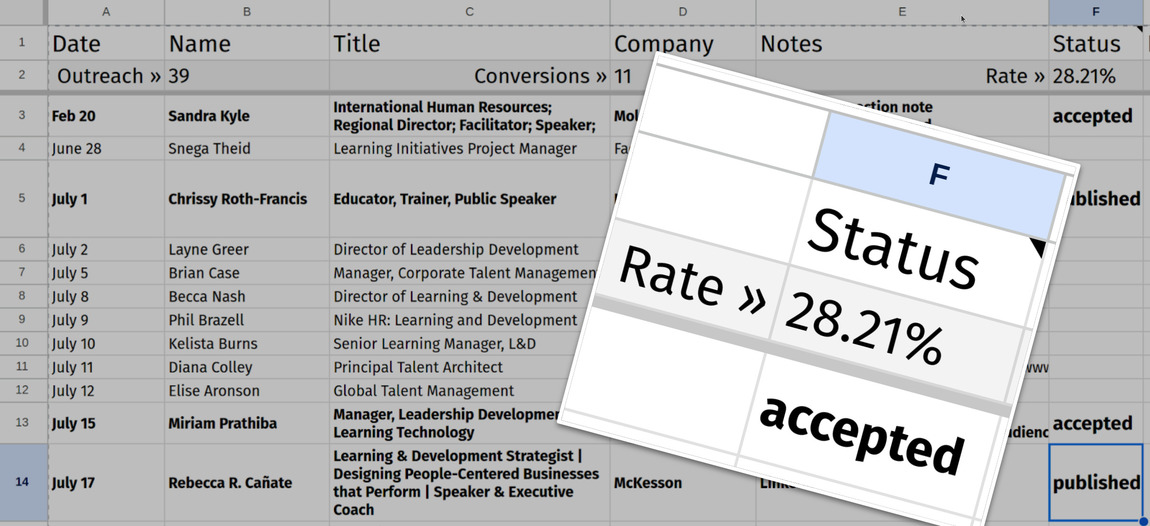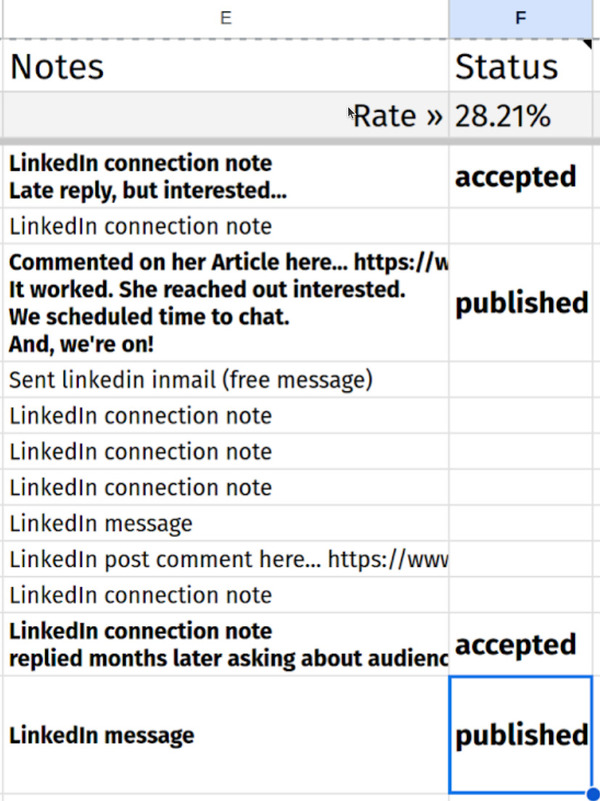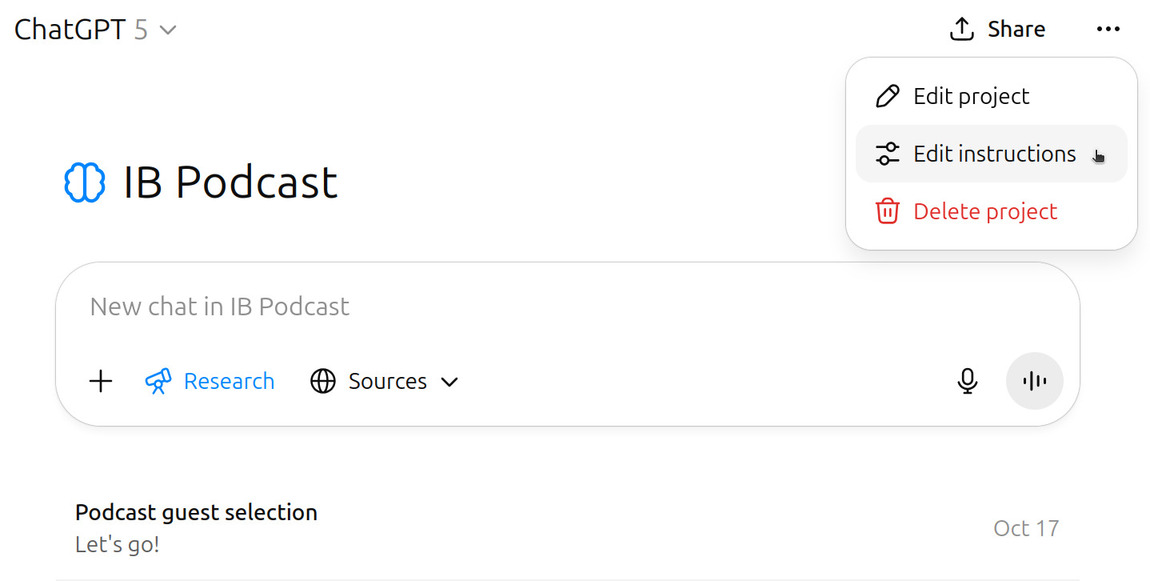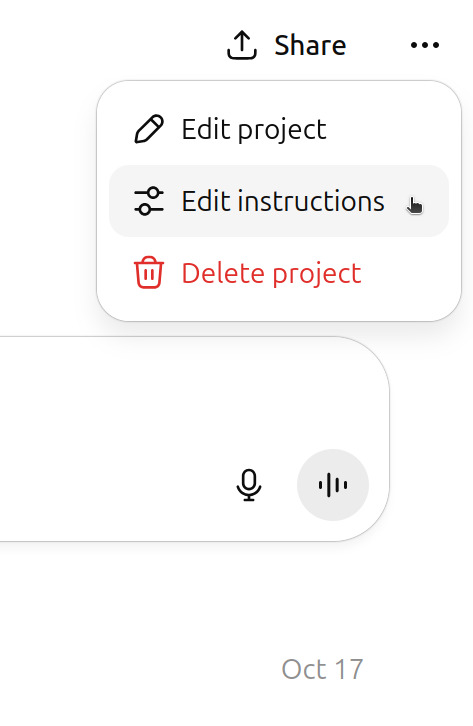Download the slides here: 📑 Podcast Outreach Tactic With A.I.
Costa Michailidis
Executive Director at Innovation Bound
Excited to share this proven method with you and how we enhanced it with ChatGPT (Deep Research & Custom GPTs).
How we got a 28% positive reply rate from cold outreach
Estimated Time to Complete: 20 to 25 minutes
Download the slides here: 📑 Podcast Outreach Tactic With A.I.
At an average of 28% positive replies, this cold outreach technique was very successful for us.


We've done this two separate times with two different audiences and both worked. Also, I have done it as the business owner, and when I delegated the work to my employee, she got even better results, so it's not reliant on the founder.
Here's the basic step-by-step:
Bartholomew, I loved what you said about AI Image Editing on Instagram! Would you like to be the next guest on my podcast and talk about that + other passions/interests?
We were very nervous when we started that people wouldn't want to be a guest on a new or very small podcast, but we were wrong. It never even came up.
We are grateful for every podcast guest we've had, have produced beautiful content for them, made donations in their names, and in general honored and celebrated our guests. See our podcast here: Are You Innovation Bound?
If yours is an early stage company, this is a great tactic for 1) testing your product or service, 2) testing your lead magnets, and 3) building your network.
For you a podcast episode is essentially an opportunitiy to talk to your customer face-to-face for an hour, and then reach out to them again from time to time.
Half the advice I give to startups is some form of 'talk to your customers.'
Paul Graham, Founder at Y Combinator
If you are an established business, the podcast outreach tactic is a great way to 1) grow your brand with long form content, 2) build an affiliate/referral network, and 3) expand into a new market or vertical.
For established businesses, the opportunity to get face-to-face in a podcast can be used numerous ways.
Of course, it's also a fantastic way to build a person brand, which can be important for any business owner.
Okay, let's dig into the details and discuss how we're enhacing the tactic with A.I...
Your first step is to identify your target audience for your podcast outreach.
Remember, you might want to target your ideal customer or someone well-networked with them. Here is a prompt to use with ChatGPT to figure this out (feel free to edit it to suit your needs)...
📋 Click or tap on the prompt below to copy it, and paste it into ChatGPT.
Now, if you use the prompt above, you'll have a starting point, and the best thing to do is to send the first 10 to 25 invites to be on the podcast by hand.
You'll want to do this yourself at first, because you'll need to understand at a detailed level what it takes to find a good podcast guest, before trying to automate this.
Once, you've done lots of outreaches and actually recorded your first few podcasts, you can return here for the automation advice below...
One of our favorite tools available in ChatGPT is Deep Research. It allows ChatGPT to work for an extended period, usually with a research focus, and this is perfect for building a nice list of potential podcast guests.
Depending on how extensively you want to automate things, you can create a Project for your podcast prospecting, and use the instructions (see image below) to instruct ChatGPT on how to do the searching and prospecting.


How to write great Instructions so ChatGPT does exactly what you need is a whole separate topic that we give extensive training on, because it's useful in a huge array of use cases, not just with prospecting.
For now let's highlight a few things:
Then, in order to make this something that works many times, not just once, you want to find a way to break up your prospecting across a few areas (geography, industry, etc).
That way, you can run your first Deep Research on New York and the real estate industry for example, and the next Deep Research on San Diego and construction, etc, until you've gone through all the relevant locations and industries (or whatever factors your broke down your searches with). Each Deep Research will bring back lists of prospects, first drafts of outreach messages, and contact info.
📋 Here's an example prompt for the Deep Research:
Again, you'll want to do the first searches on your own, or with limited ChatGPT use, so you can learn what makes for a great podcast guest first, and only automate after.
Next, a little more on messaging...
When I deligated podcast outreach to my employee, she got much better results than me: 50% positive reply rate at first.
I asked her how, and she said, "I think, because I'm really looking for someone I'd genuinely want to talk to."
Being more selective about who you invite onto the podcast will not only lead to a higher positive reply rate. It will lead to better conversations, a more genuine new connection in your network, more and better referrals, and ultimately more/better customers.
The path to higher quantities (bigger business) is gotten through higher quality on your part. I mean, obviously, people want the best their money (or time) can buy.
By time I mean that people are much more protective about how they spend their time than their money. This is why sometimes starting out in business you can't even give your product or service away for free, because people still have to buy with their time. Even a free product costs them 5 minutes or an hour, and that time is precious.
After someone accepts your invite, you'll want to schedule your prep session. We usually ask for 30 minutes.
Something like, "Excellent! Excited to have you join the podcast. Let's set up a prep session first to quickly get to know one another and to help me draft a list of questions/topics for your podcast episode. When do you have 30 minutes to hop on Zoom?"
You're going to want to record your prep session (and then transcribe it) which is quite easy with Zoom, or use an AI note taking tool like Gemini in Google Meet.
Either of these solutions, or many others, will result in the full text (or notes) from your podcast prep conversation.
📋 Take those notes, paste them into ChatGPT along with the following prompt:
If you don't like ChatGPT's output, DO NOT REPLY. Instead, edit your original prompt, and change it so you get a good response. This is an important best case practice.
We go over this in our training programs in detail, but in short... You don't want bad output anywhere in your chats, if you can help it. Go back and use the edit feature when you get bad responses, and adjust what you asked for so ChatGPT understands better and produces a better answer. This is especially important in longer conversations.
Ah, and before you finish your prep session, make sure to put your recording session on the calendar as soon as possible.
There are many ways to record and produce a podcast. Let me list a few for you.
We use Riverside and it's been pretty good for us. You can also just record on Zoom, or of course go for the most beautiful in person at the studio.
If you are limited on time and money, the simplest approach is to use YouTube Live or LinkedIn Live or any of the social media Live broadcast options. Since it's live, it automatically posts with no edits, and so... no editing costs. It also gets published very quickly, but of course no retries, edits, or touching anything up. If the cat jumps on the keyboard, the cat will be in the podcast.
Also, if this is your first time recording... Just stay calm, be casual, and treat it like a normal, thoughtful conversation. Try your best not to interrupt, listen intently, and enjoy!
You're going to have a recording of your podcast episode, and you can do a number of things with that, beyond posting the full episode.
You can export a transcript (full text) of the podcast, and drop that in ChatGPT (or Gemini if the transcript is too big for ChatGPT) and ask for tweets or social media post content.
You can also ask for suggestions on which parts to make clips of that are the most interesting/drammatic/etc.
You can also ask for suggestions on when and how to follow up with your podcast guest.
📋 Get X.com posts (Tweets):
📋 Get LinkedIn posts:
📋 Get clip suggestions:
There are also fanstics tools like Opus Clip and built into Riverside that automatically generate video cilps.
Are you beginning to see a few patterns yet in how we use ChatGPT?
If we can get ChatGPT to interview us on relevant info to help it do a good job, we do that, because it's faster than trying to think of everything we should tell it ourselves.
When prompting, we give the goal, background info, and ask it to provide its reponse in a particular format like a table with certain columns.
These are just some basic tips. We go much farther in our training programs. ChatGPT is a profoundly powerful tool if used skillfully.
Spotify, Apple, and YouTube are the most common places people listen to podcasts.
Here is a quick prompt to get ChatGPT to help you share your podcast on these platforms.
📋 In general, ChatGPT is pretty great at tech support, even though it makes mistakes.
For this one you can use Deep Research or Thinking or even Pro mode.
Be aware, ChatGPT will make mistakes in its tech support (all these apps, Shopify/YouTube/Apple, have new versions every year or every six months, so ChatGPT may tell you to click something and it isn't there. Just take a screenshot of what you see and paste it into ChatGPT, then ask it to adjust its guidance.
You're going to want to produce beautiful content for you guest.
Imagine spending an hour of your time on someone else's podcast, and they send back something with spotty audio, bad lighting, or worse, the ending missing...
You really don't want to do that to your guest, and I mentioned this because I've done it. I used to host TEDx Events, and we've had audio glitches, we've had the lights go out mid talk, we had speakers forget to turn on their mics, and most recently the team that took over the event lost the website... permanently. Imagine my damage control job.
Quality is more important than speed here. Make sure to produce beautiful content for your guest.
There are a host of tools for speeding up and improving audio and video editing.
Some are from long time industry leaders like Adobe and some from new players like Runway and ElevenLabs.
Check out the quick AI Extend demo from Adobe in this video...
Andrew James Ferris on our team has crafted beautiful content throughout his career and with AI Tools as they've emerged in the last few years. He's done all our podcast episodes.
You have now essentially made a new friend, and new network connection.
And you can now ask for a referral or connection, and they're likely to help you out, but...
Certain things will increase your chances of getting great referrals:
(Results will of course vary from person to person.)
The psychologically tendency to want to do nice things for people who've done nice things for us is reciprocity. It's not even limited to humans. We observe it across many animals.
You've done something very nice for your podcast guest by creating beautiful content for them, and if you do even more you can increase your chances of reciprocity.
When we first did our podcast outreach we donated money to charity in the person's name and sent them a thank you video from on site so they can see the impact of the donation: 🪸 Thank You From The Coral Reef »
Understand, reciprocity helps, but you still get zero referrals if you don't do the next thing...
When you ask for referrals, you can simply ask, Who do you know that would value my expertise/product/service?
This might get you some introductions, but it's a bit of a hard sell, and you might get nothing. What's worse is that that person might not want to help you out in the future... You may lose your new friend.
If you really want a great result here, you should be presenting your best lead magnet, your most heavily discounted product or service, or a proven offer that you know works.
We've asked podcast guests to invite people to our demo sessions, connect us to people for free trials, and so on. These have worked well for us, and some of those leads have gone on to become customers. From there, it's just about doing the math to see what it's costing you to acquire customers this way.
This is also a great opportunity to test new lead magnets with zero risk.
Just present the new lead magnet with the old one that you know works, or present the new one first, and if you don't get a strong reaction have the old, proven one in your back pocket.
Our A.I. Accelerator includes a whole training on how to build great lead magnets with help from A.I. tools.
Alright, let's wrap this up...
You're going to want to send the occasional message to your new network connection to keep in touch with them.
The more personalized and the more valuable these follow ups are, the stronger your connection will become. If they make a referral for you and your service goes well, that's an easy reason to follow up, but let's use ChatGPT and get creative...
Remember those transcripts of the prep and podcast you have?
📋 Drop your transcripts into ChatGPT and get follow up suggestions:
If ChatGPT can't handle the length of these two documents, try Gemini from Google. The input length these AI tools can handle is increasing with each new release. This is called the Context Window
if you want to research it and learn more.
If you start with one podcast episode per month and build up to one per week as you optimize your process with the AI techniques we discussed, you can increase your network by 50 people per year plus all the referrals these folks can make for you.
And, if you invite 50 of your past podcast guests to an event and ask them to invite their colleagues and friends, well now you have yourself a well-attended event, plus you've got tons of amazing content for your social media game.
This really is a nice core marketing tactic... In fact, we've recently revived this tactic for our business. Check out our recent episodes here: Are You Innovation Bound?
This podcast tactic we just went over is a great way to build your network, personal brand, and get referrals for your business, all made easier with modern AI tools.
We'd love to learn more about your business and help you grow by mastering modern AI tools.
Learn more about us or our training programs...